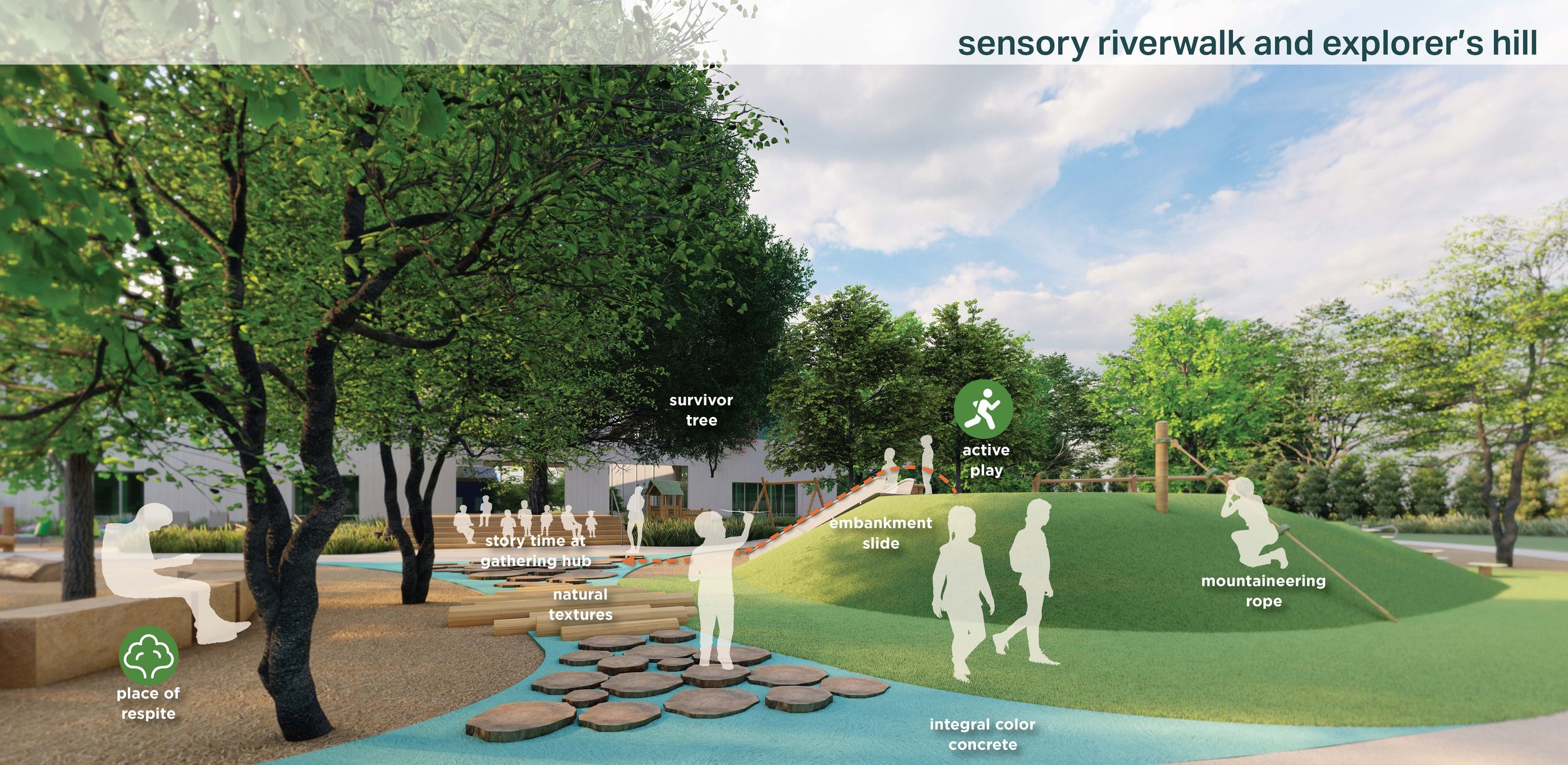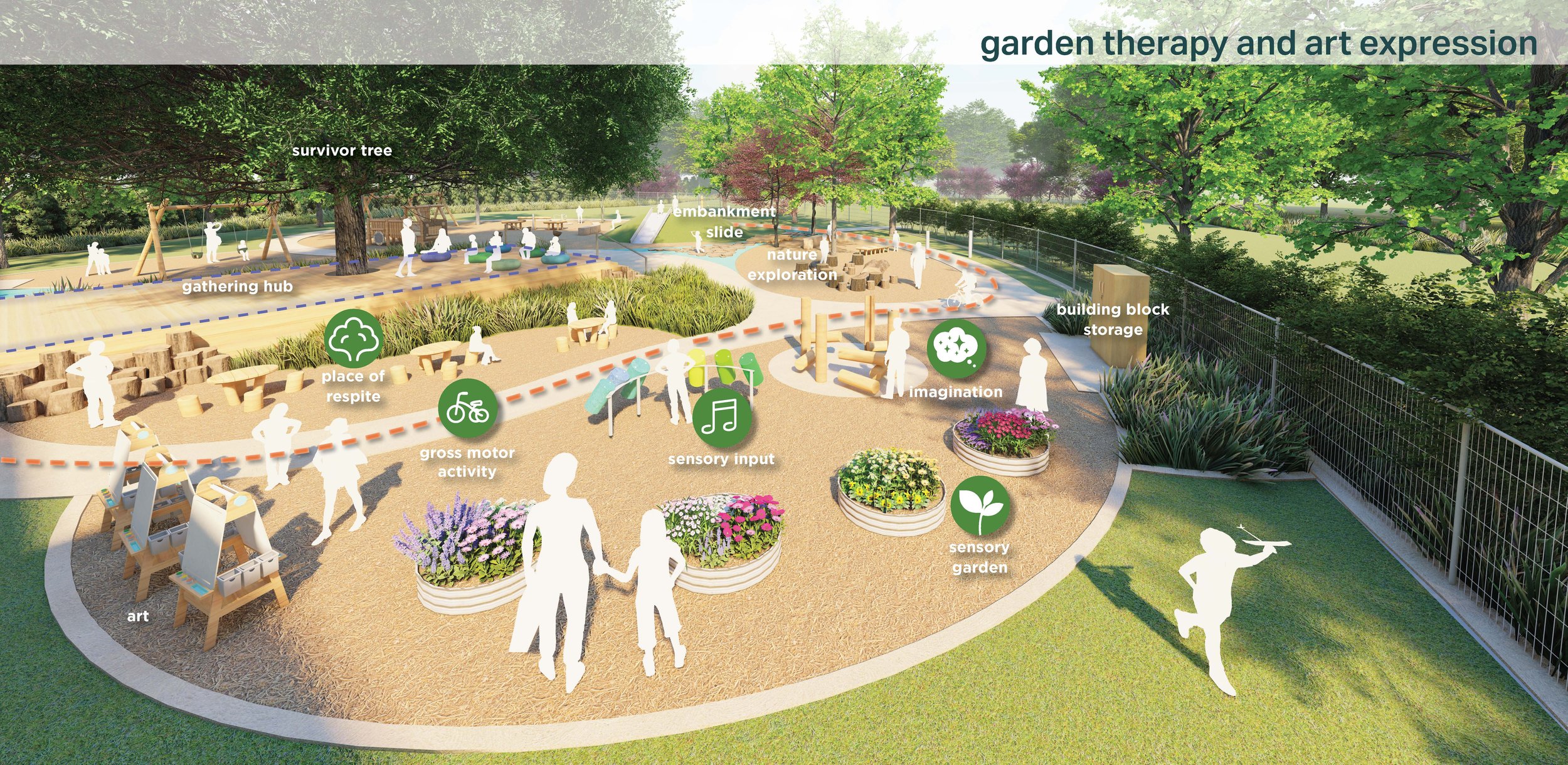In light of the Center for Transforming Lives receiving a 2024 Texas ASLA Merit Award, outsider Declan Devine interviewed Amy Wagenfeld to discuss “Trauma-Responsive Design in Collaboration with Nature.” Wagenfeld is a therapeutic and developmental design consultant with over two decades of experience designing inclusive and accessible spaces that promote health and well-being.
Formed in 1907 to support local low-income women, the Center for Transforming Lives has over a century of experience fostering regeneration. Their new campus, created through the adaptive reuse of a vacant 1950s Montgomery Ward department store on a 14-acre site, is designed around healing landscapes. By removing one-fifth of the building's roof, they have created a secure open-air courtyard that houses a meditation garden and fills the interior with natural light. The surrounding trauma-responsive landscapes and outdoor play spaces offer various features to support each child's unique healing journey.
Coming from a background in occupational therapy, what sparked your interest in the work of trauma-responsive landscapes?
AW: Occupational therapists have been leaders in providing trauma-responsive care for many years. This type of care extends from childhood through end of life. A common thread for all types of impactful therapy services is the environments in which they are provided. Being an unabashed believer in the health benefits of nature and an occupational therapist, I recognized early on in my work the importance of designing nature-rich environments as spaces for healing. These spaces can be formally designed as therapeutic environments for addressing trauma or other specific purposes like physical rehabilitation or inclusive play. They can also be designed to offer more general benefits to all users of the spaces. Lacking a background in occupational therapy, as a practitioner and educator, I don’t think that I would truly understand what these spaces need for users to have opportunities to heal and for therapists to do their best work.
Adaptive reuse of the building included removing the roof to create a secure open-air courtyard on axis with the Survivor Tree and wrapping the building with trauma responsive landscapes.
What does trauma-responsive design mean to you?
AW: To me, trauma-responsive design acknowledges that environments (inside and outside) must be created to support people who have or are experiencing trauma of any kind. They should never exacerbate the trauma. Instead, they are intentionally designed spaces where no matter how the trauma is being manifested, physically, sensorially, or emotionally, users’ needs can be met. By its very nature, trauma-responsive design is complex, as trauma and people’s responses to trauma vary widely.
I firmly believe and have first-hand experience in my work that the most impactful trauma-responsive spaces are those that were designed through a highly engaged and collaborative interdisciplinary process. Onboarding occupational therapy in the very early stages of the project, be it helping to write proposals (we have the language!) or certainly at the beginning of SD makes the most sense- we can all be on the same page from the outset with shared goals and intentions.
The design team collaborated with an occupational therapist on a trauma responsive approach. Play programming also references emotional intelligence framework for children established by Yale research psychologist Marc Brackett.
How can designed landscapes and natural environments aid in the process of healing?
AW: The good news is that extensive and ongoing research finds that designed and natural (environmental) connections with nature have the capacity to aid in the physical and emotional healing process. And they can support learning and thinking throughout life. While every project needs and deserves its own design considerations, providing a range of experiences for people to ‘chart their own healing journey’ in a space is foundational. I guess it boils down to providing opportunities for choice and agency, and yes, affordances!
We talk a lot about providing ample affordances in trauma-responsive landscapes. Can you elaborate on the importance of providing affordances for those who have gone through traumatic experiences?
AW: I agree that providing opportunities for everyone to experience a range of affordances or action experiences in the outdoor environment is important. In my mind, the keyword is ‘range.’ People who are experiencing trauma can and do respond to the outdoor environment in different ways (same for indoor environments). Some may embrace and seek out a wide range of affordances and others may select a narrower range. The astute trauma-responsive design team recognizes this and designs to provide different kinds and levels of affordances and transitional spaces in between to allow users of the space a safe place to reset and decide what, if any, affordance they choose to engage with next.


Do you approach trauma-responsive design differently for children vs. adults?
AW: Yes and no. Understanding that children and adults can and do experience trauma acknowledges that it happens throughout life. Childhood trauma is often referred to as adverse childhood experiences (ACEs). The impact of ACEs in adulthood can negatively impact physical health and challenges with learning and relationship building. This is a long-winded way of saying that trauma is not isolated to one period of life. A trauma-responsive (or any kind of therapeutic) design process should reflect where a person or user group is in their developmental trajectory, such as an outdoor environment for children, teens, adults, or older adults, or a multi-age space. A child’s developmental skills and needs differ from an adult’s needs, and design should consider that. I like to think developmentally in my trauma-responsive design process.
That said, it is important to understand human development for any type of design project, but even more so a therapeutic one. For example, a trauma-responsive space for children would most likely have a carefully balanced play focus to promote emotional regulation. But to be honest, we need to play at all stages of life, and in some capacity, it has its place in all trauma-responsive design! But play for a child is different than for an adult, so playful elements in a trauma-responsive landscape at, say, an outpatient veteran’s clinic would look different than in a children’s landscape.
Parents in a relaxed mindset provide more stability. The meditation courtyard brims with seating nooks to retreat between lush plantings and an outdoor plaza sized for yoga or small groups.
What are some design elements or strategies you think could be utilized to integrate moments for healing into the landscape, even when it might not be the project’s focus?
AW: First off, a universal design focus needs to be front and center for impactful therapeutic design. Dovetailing onto universal design, providing choice in the landscape is very important. For example, in times of unrest and trauma, people may feel like they have little agency in their lives. Landscapes that provide equitable options to be more active or passive are invaluable to users. Let me use water as an example because it is often a highly requested element. Is there an option to include water to look at and listen to (passive), to touch or play in (active)?
Are there any other exciting projects you’ve been working on lately that you’d like to share?
AW: Thanks for asking! Here are a few of the projects I am working on. I am finishing up a project, the Joy Evans Therapeutic Recreation Center, with the DLR Group Washington, DC office. I have used my therapeutic design skills on this project to assist with the process from proposal writing, interviewing, community engagement, public art selection, and all stages of the design process through CD. My contributions to the Center have spanned landscape, architecture, and interior design. I am also working with the DLR Group Minneapolis office on a women’s prison project, and several inclusive playground projects with O’Dell Engineering, a Westwood Company. I love what I do as a therapeutic designer and also as faculty in the Department of Landscape Architecture, where I co-teach design studio courses and solo teach therapeutic-focused seminars such as Human Development for Designers and Sensory Responsive Design!












